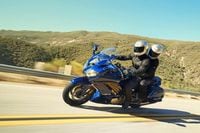The Yamaha FJR1300ES is proof that a good touring package can take you a long way.
Not only does Yamaha’s biggest sport-touring model offer great long-range comfort, it’s been a staple of the company’s Sport Touring lineup for years, and it’s managed this without significant technological updates. As the saying goes, “If it ain’t broke, don’t fix it.”
Last updated in 2016, the current-generation FJR has a modest yet respectable list of features, including two throttle modes, traction control, cruise control, electronically adjustable suspension, and lean-angle-sensitive LED lights.
Power comes from a 1,298cc liquid-cooled inline-four cylinder engine with a tall sixth gear. The leads to reduced revs at sustained highway speeds, and thus, tour-friendly fuel mileage. The FJR has never been a buzzy motorcycle, but shifting into sixth gear it’s so smooth that it’s eerie. This is aided by the fact that the engine is barely turning 3,500 rpm while cruising at 75 mph.
The chassis is a similar combination of proven hardware that simply works. A twin-spar aluminum frame, shaft drive, and electronically adjustable suspension offer plenty of comfort for long days in the saddle plus enough performance for sporty backroad action. Despite weighing a claimed 642 pounds, the bike handles well, and it’s not only until you push it hard into a corner that you’ll sense the bike’s heft and slight lack of cornering clearance.
Electronically adjusted suspension has four preload settings, three damping settings, and seven damping adjustments. It works, though admittedly, the system looks outdated next to the semi-active electronic suspension systems elsewhere in the sport-touring category. Brakes consist of Nissin calipers biting on dual 320mm discs up front and a 282mm disc in the rear. Importantly, the bike uses an Inertial Measurement Unit (IMU) to control the cornering lights, but the antilock brakes and traction control aren’t lean-angle sensitive.
Most riders consider the FJR’s riding position to be “just right,” and only a bit cramped if they have longer legs. Luckily, the thick, well-cushioned seat can be adjusted 0.8 inch without tools. Similarly, the handlebars can be set to one of three positions and the windscreen is electronically adjustable for a range over 5.1 inches. The fuel tank holds 6.6 gallons of gas.
Other practical features include: integrated hard luggage, heated grips, adjustable fairing side panels that help direct airflow, and a fairing-integrated glove box with a 12V outlet. The analog and LCD displays look dated but are very functional.
That theme carries throughout the rest of the bike. The FJR lacks modernity and appears outdated when parked next to the competition. There’s no adaptive cruise control or blind spot detection, and Yamaha’s carryover electronic rider aids are about as simple as it gets in 2024. Despite all that, the FJR has a way of disappearing underneath you on an open stretch of highway, making it a great option for riders who want simple, straightforward performance without layers of technology piled on top.
The 2024 FJR1300ES is available in Yamaha’s Cobalt Blue color, with pricing starting at $18,299.















/cloudfront-us-east-1.images.arcpublishing.com/octane/G4MG6OUCJNBSHIS2MVVOTPX65E.jpg)
/cloudfront-us-east-1.images.arcpublishing.com/octane/IIGGWFOTOJGB7DB6DGBXCCMTDY.jpg)
/cloudfront-us-east-1.images.arcpublishing.com/octane/QSTCM6AVEZA5JJBUXNIQ3DSOF4.jpg)
/cloudfront-us-east-1.images.arcpublishing.com/octane/U4I7G625B5DMLF2DVIJDFZVV6M.jpg)
/cloudfront-us-east-1.images.arcpublishing.com/octane/B6XD6LS6IVCQPIU6HXDJSM3FHY.jpg)
/cloudfront-us-east-1.images.arcpublishing.com/octane/ICL63FEDDRDTTMINYICCEYGMDA.jpg)
/cloudfront-us-east-1.images.arcpublishing.com/octane/FCGZHQXRBZFLBAPC5SDIQLVF4I.jpg)
/cloudfront-us-east-1.images.arcpublishing.com/octane/WNOB6LDOIFFHJKPSVIWDYUGOPM.jpg)

/cloudfront-us-east-1.images.arcpublishing.com/octane/X33NU3E525ECRHXLNUJN2FTRKI.jpg)
/cloudfront-us-east-1.images.arcpublishing.com/octane/6KKT5NNL2JAVBOXMZYS5ZO76YA.jpg)
/cloudfront-us-east-1.images.arcpublishing.com/octane/J5RKG5O455GMPGQRF2OG6LRT7A.jpg)
/cloudfront-us-east-1.images.arcpublishing.com/octane/GX2CIZKQVRH2TATDM26KFG2DAE.jpg)
/cloudfront-us-east-1.images.arcpublishing.com/octane/ZWIDYSAKQZHD5BHREMQILXJCGM.jpg)
/cloudfront-us-east-1.images.arcpublishing.com/octane/CYUHJZCTSJCH3MRAQEIKXK7SCQ.jpg)
/cloudfront-us-east-1.images.arcpublishing.com/octane/LKOFINY56FCXJCANJ5M7ZDQUBY.jpg)
/cloudfront-us-east-1.images.arcpublishing.com/octane/4NBPDACMWJH63JQYJVK3QRBDZI.jpg)
/cloudfront-us-east-1.images.arcpublishing.com/octane/KKHQHRR3FJGX7H2IPU6RALMWG4.jpg)

/cloudfront-us-east-1.images.arcpublishing.com/octane/5IOFS5JAE5FOXMNA23ZRAVVYUU.jpg)
/cloudfront-us-east-1.images.arcpublishing.com/octane/CGXQ3O2VVJF7PGTYR3QICTLDLM.jpg)

/cloudfront-us-east-1.images.arcpublishing.com/octane/OQVCJOABCFC5NBEF2KIGRCV3XA.jpg)
/cloudfront-us-east-1.images.arcpublishing.com/octane/OPVQ7R4EFNCLRDPSQT4FBZCS2A.jpg)